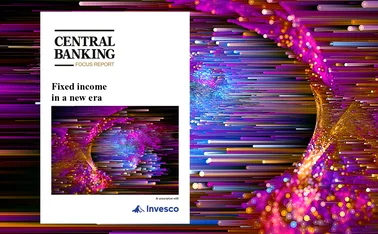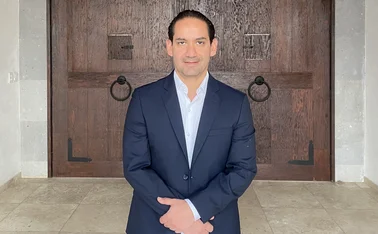

A turning point for reserve managers?
After many central banks’ reserves declined in 2022, how should managers evaluate their fixed income investment policies in an uncertain period following years of unprecedented shocks?
Global foreign reserves decreased from $12.9 trillion in the fourth quarter of 2021 to $11.5 trillion in Q3 of 2022, according to the International Monetary Fund’s (IMF’s) Currency composition of official foreign exchange reserves (Cofer).
Foreign exchange interventions – particularly those of emerging economy central banks to dampen volatility caused by sharp portfolio outflows – were one reason reserves declined, but FX reserve revaluations also played an important role. As central banks – notably the US Federal Reserve Board – raised rates to tame above-target inflation, sovereign bond yields rose, meaning the value of short-dated US Treasury bond portfolios declined. The Bloomberg US Treasury bond 1–3-year total return index, which approximates part of a typical FX reserves investment portfolio, decreased by just under 4% in 2022.
“Even the returns of those with a shorter duration suffered,” Marco Ruiz, manager at the World Bank’s Reserve Advisory and Management Partnership (Ramp) – which offers technical advisory and asset management services – tells Central Banking. The Reserve benchmarks 2023 report indicated that average duration at 55 central banks stood at 25 months during the previous 12 months.
“Almost all the institutions we talked to expressed that losses were a significant concern for the board. These have probably been the worst two years in fixed income history, considering how low interest rates were,” he says. “Since the creation of those benchmarks 40 years ago, never have those indexes had a negative return,” Ruiz adds. Indeed, some central banks had never seen negative returns before: “That was a significant shock.”
Even central banks that had diversified their fixed income portfolios – for instance, into mortgage-backed securities (MBS) – faced significant issues. “The return on MBS for long-duration instruments was actually even worse than it was for short-term Treasuries,” says Ruiz. Concerns the Fed would flood the MBS market contributed to double-digit losses for some MBS indexes last year. It was a similar story for those that had invested in equities: their historical inverse price correlation to bonds largely failed – at least in 2022.
Another reason for reduced FX reserves was outflow from reserves in some countries to repay foreign currency government debt, says Freyr Hermannsson, an independent adviser who works with multiple central banks and international institutions.
Many central banks, which are not used to showing losses on financial statements, are now reconsidering their portfolios, given boards and stakeholders were not satisfied with their performance, says Ruiz. Nonetheless, he says, a Ramp survey published in November found that “central banks’ investment management policies were resilient considering what happened last year”.
A turning point in a new era
Many consider now is a sensible time to reflect on lessons to be learnt and an opportunity to reassess goals. Doubling down on fixed income may be an option, should rates be close to their terminal levels.
“When the Fed raised interest rates, we had some mark-to-market losses – as did many central banks,” Timothy Antoine, governor of the Eastern Caribbean Central Bank, which holds reserves in short-dated investments to back its currency peg, says in a wide-ranging interview. “Now we are enjoying the benefit of high interest rates in terms of our investment income. Our reserves are growing.”
Indeed, Hermannsson says that, when it comes to the ‘holy trinity of reserves management’ – security, liquidity, return – “now, for the first time in 15 years, it is legitimate to expect fixed income assets to provide all three”. This may come as a surprise to many reserve managers, which have only operated in the years following the financial crisis [that began in 2007–08], when interest rates stood at the lower bound across most jurisdictions due to below-target inflation and so struggled to hit return criteria. “That era has ended and there’s a new environment.”
Ruiz adds: “If we have reached terminal rates, it’s really a moment to reassess the whole investment policy and see how to take advantage of the moment.”
In Ruiz’s view, the fact that “interest rates are increasing”, and that “natural rates are increasing” is a good thing in the long term because “it improves return prospects”. The reason for this, he explains, is that “in periods where we saw interest rate increases in the past, we saw negative returns in the very short term, but better returns over a longer time horizon”.
But, as discussions at the Central Banking Autumn Meetings in November indicate, there is no quorum of reserve manager views – even within institutions – when it comes to a conviction that rates have topped out. At one Group of 20 central bank “the debate became a dilemma” during its recent strategic asset allocation review, an official of that central bank said. Some colleagues had proposed that the duration of a small portion of reserves should be increased to make the most of higher-for-longer rates. By contrast, others proposed that it would make sense to reduce the duration of the portfolio because they expected elevated volatility to continue.
“We’ve been discussing terminal rates for two years,” Ruiz points out. However, even if a reserve manager takes a “relatively conservative” approach in the portfolio and invests in US treasuries, they will secure close to a 5% return, he adds.
This would allow reserve managers to “maintain a core of short-term instruments” in their portfolio while also “diversifying into other products, and still having some carry that would allow them to manage the volatility of these products”, says Ruiz.
The official at the G20 central bank said the result of the internal discussion was not to make any changes, for now. The latest Cofer data, however, indicates reserve levels are rising once more, exceeding $12 trillion by Q3 of this year. And some central banks are changing their allocations.
“Given current yield levels and market expectations, we have cautiously increased duration, from very low levels, to increase expected returns,” Andrés Cabrales, head of the international investments department at the Central Bank of Colombia, told a fixed income reserves panel.
Cabrales observed that interest rate policies can influence fixed income investments if monetary policy cycles synchronise. “We continue to analyse new asset classes and increase allocations in others to enhance diversification and achieve improved risk/return metrics,” he added.
“As globally higher interest rates make longer-dated bonds and a broader set of currencies attractive for reserve managers, we use this opportunity to diversify our portfolio further,” Jonas Kanapeckas, director of market operations at the Bank of Lithuania, told the panel.
To limit exposure to interest rate timing risk, “at a strategic level, we focus more on longer-term, more stable portfolio risk/return factors and general diversification goals”, Kanapeckas added.
Ruiz stressed that “reserve management” is not about “market timing”.
Another complicating factor for central banks is negative carry, given domestic policy rates are often much higher than reserve currency policy rates. “The cost of carry matters because, when central banks intervene in the domestic FX market to accumulate reserves, they buy dollars and they sell their own currency, which often requires sterilisation,” says Ruiz. “That’s where the negative carry materialises.” When the negative carry is too large, it is more costly for central banks to increase reserves.
In some countries the cost of carry is higher than usual, and some central banks may be more hesitant to increase their levels of reserves, though in some cases they may need to, Ruiz says. Notably, in October, the Central Bank of Chile said it would suspend its programme to replenish international reserves because of instability in global financial markets.
Another option is to slow the pace of growth of reserves, making it more gradual than rapid, to mitigate the cost of carry. However, having sufficient baseline reserves is still essential, despite any carry costs concerns.
There are also mechanisms to boost returns for those with high levels of reserves. “We have addressed this problem by enhancing the return profile of our portfolio while safeguarding liquidity and capital preservation,” Gerardo García, director general of central banking operations at Bank of Mexico (Banxico), told Central Banking in an in-depth interview. “One way to achieve this is by finding additional sources of diversification to reduce the gap in interest rate differentials.”
The nominal interest rate in Mexico was 11.25% in November, while the interest rate for two‑year notes, which most closely resemble the duration of Banxico’s portfolio, was around 5.25%. The 6% interest rate differential paid on the liability side reflects the cost of carry.
Banxico uses systematic yield enhancers and, to reduce the cost of carry, reserve managers can also switch “a little bit away from Treasuries into, for example, agencies or supranationals or corporates”, García said. “It’s important to emphasise that, while we seek to minimise the cost of carry, our primary objective remains maintaining reserves at adequate levels. In this regard, closing the gap is not necessarily the highest priority,” he added.
Banxico also exploits interest rate differentials by engaging in basis swap transactions via derivatives as part of its tactical trading efforts.
Changing market dynamics
Another problem from reserve managers is that expectations around rate paths have been priced differently in markets. “This year there has been an expectation of a slower pace of increasing interest rates. That expectation is seen in the short term of the [yield] curve, but it hasn’t happened in the long end,” says Ruiz. For institutions that have instruments with longer durations, those instruments have also underperformed in 2023.
Hermannsson says reserve managers also need to remember that they should not only strive to maintain the real value of the reserves over time, but also aim to achieve appropriate risk-adjusted returns on the public asset they hold.
“Reserve managers that hold reserves that are financed with government borrowing need to be aware that the situation with the government foreign financing may have changed,” he says. Debt rollover has become more expensive and, in some cases, challenging. “This will directly impact reserve adequacy.”
At the Central Banking Autumn Meetings, one official said: “We recognise there is an increasing call on reserves.” This official’s central bank has a liquidity tranche that is the backstop of the working capital tranche. Earlier this year, the central bank “did a detailed liquidity stress-testing exercise”, and adjusted the range for the liquidity tranche so “we do not run into the problem of pulling funds from external managers”.
Hermannsson also points to “an ongoing unwind of quantitative easing, which presents uncertainty for government bond markets in reserve currencies”.
A liquidity risk that is important for reserve managers to consider is that “it isn’t clear what the path is going to be with these unwinds, while the effect will be profound”.
Hermannsson cites the UK as an example. “The Bank of England [BoE] has been the dominant buyer of gilts for the past decade, now holding one‑third of all gilts.” However, as the BoE engages in quantitative tightening, “it has become a seller”. There are also indications that one of the largest group of bondholders – pension funds – could turn to selling going forward, especially those running defined-benefit pension funds, he says. “At the same time, the government needs to finance a budget deficit under higher interest costs. Who will be the buyer?” The UK “is far from being the only country that is dealing with this situation”, he adds.
More broadly, since the financial crisis, levels of debt have risen, says Hermannsson. Private debt has fallen, but debt has migrated to the public sector.
“As we have already seen with the European Central Bank, central banks will be looking to change monetary operations to improve the efficiency of their monetary policies as a response,” he says. “Markets should also be prepared for a public policy rethink given the added cost of financing budget deficits and the roll-over of legacy debt.”
Furthermore, “we haven’t yet fully seen the impact of higher rates on public debt. The full impact of higher rates is still filtering into the system,” Hermannsson adds. As a result, “we’re starting to see central banks that have acknowledged there will be substantial cash cost over time”.
Now may also be an opportune time to review the proper functioning of reserves governance structures, says Hermannsson, and also a good time to assess how risk management frameworks guided reserve managers through the 2022 transition.
In Hermannsson’s view, “reserve managers need to have a smooth decision-making process with appropriate delegation of authority, to reallocate and rebalance through these kinds of transitions”.
Long-term sustainable finance
Another significant development Ruiz says is “interest in sustainable development”. This is not only in terms of investing in sustainable instruments, he says “but also in terms of how to measure sustainability in the portfolio”.
The 2023 Invesco global sovereign asset management study shows a steady increase in green bond investment among respondents, from 28% in 2019 to 69% in 2023.
“In the new era, central banks wish to lead with a good example in transitioning markets towards more sustainable finance,” agrees Hermannsson.
The transition to green bonds is not easy, however. In efforts to meet environmental, social and governance criteria, greenwashing is viewed as “a considerable challenge” by 45% of sovereign wealth funds and central banks surveyed by Invesco.
Another “challenge often with reserve management is that policy objectives are mostly short term and it can often be difficult to obtain longer-term policy objectives such as those related to climate change”, says Hermannsson. “[Nevertheless], central banks that have ample international reserves should have a portfolio with longer-term objectives, and many have already begun
that process.”
Only users who have a paid subscription or are part of a corporate subscription are able to print or copy content.
To access these options, along with all other subscription benefits, please contact info@centralbanking.com or view our subscription options here: http://subscriptions.centralbanking.com/subscribe
You are currently unable to print this content. Please contact info@centralbanking.com to find out more.
You are currently unable to copy this content. Please contact info@centralbanking.com to find out more.
Copyright Infopro Digital Limited. All rights reserved.
You may share this content using our article tools. Printing this content is for the sole use of the Authorised User (named subscriber), as outlined in our terms and conditions - https://www.infopro-insight.com/terms-conditions/insight-subscriptions/
If you would like to purchase additional rights please email info@centralbanking.com
Copyright Infopro Digital Limited. All rights reserved.
You may share this content using our article tools. Copying this content is for the sole use of the Authorised User (named subscriber), as outlined in our terms and conditions - https://www.infopro-insight.com/terms-conditions/insight-subscriptions/
If you would like to purchase additional rights please email info@centralbanking.com
Most read
- ECB says iPhone is currently incompatible with digital euro
- Supervisors grapple with the smaller bank dilemma
- ‘Do I die, or do I survive?’ Officials reflect on Basel III complexity






